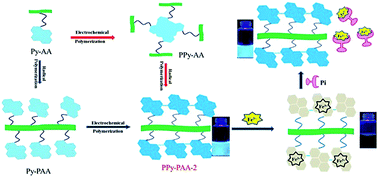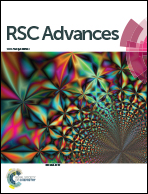Novel functionalized conjugated polypyrene with polyacrylate: synthesis, electrochemistry, luminescence, and chemical sensing properties†
Abstract
A novel acrylate modified pyrene (Py-AA) was synthesized, its free radical polymerization led to the formation of the corresponding precursor polymer polyacrylate (PAA) functionalized with pyrene (Py-PAA), while its electrochemical polymerization resulted in the uniform electrodeposition of acrylate modified polypyrene (PPy-AA) and polyacrylate modified polypyrene (PPy-PAA-1 and PPy-PAA-2). The molecular structure, electrochemical, and optical properties of as-formed polymers were systematically investigated by FT-IR, atomic force microscopy, cyclic voltammetry and UV-vis spectroscopy. In particular, PPy-AA and PPy-PAA-2 demonstrated much stronger visible color fluorescence than polypyrene and PPy-PAA-2 showed remarkable fluorescence solvatochromism in various solvents. PPy-PAA-2 exerts exemplary activity as a fluorescence chemosensor and accomplishes monitoring of important biological targets like Fe3+ and inorganic phosphate. Once bound with of Fe3+, the fluorescence of PPy-PAA-2 was quenched by 97% in label free conditions. The fluorescence of PPy-PAA-2 was regained on adding inorganic phosphate with a fluorescence enhancement of 99% due to the displacement of Fe3+ from PPy-PAA-2.


 Please wait while we load your content...
Please wait while we load your content...